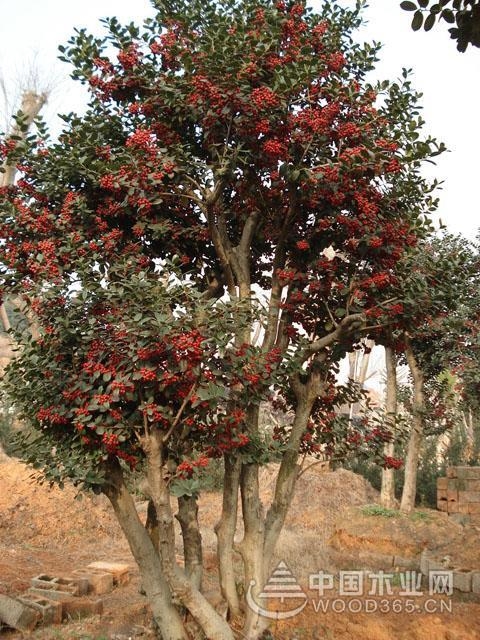The sacrum tree is a relatively common tree species for garden landscapes. It belongs to shrub species. However, because its branches are relatively flexible and very malleable, it is often used to make bonsai tree bonsai, which can greatly enhance 枸. The ornamental value of the bone tree itself. In the maintenance of the bonsai tree bonsai, it is mainly based on sowing and breeding, and it can also be used for cutting and tillering. The bones after the survival can be made into different types of bonsai according to the shape of the stump, such as lying, dry, and dry. .

The sacrum tree is a kind of tree that is not very cold-tolerant and grows slowly. It needs to be fertilized and other care in its maintenance to ensure its healthy growth.
Bones tree bonsai introduction
Features: The tibia is not cold-resistant and grows slowly, so it is necessary to apply more phosphate fertilizer so that it can be densely colored. Birds are often attracted to the fruit and are therefore protected during fruiting. Although it prefers acidic, fertile soil with plenty of sunshine, warm weather and good drainage, don't go straight in the summer. The branches of the tibia are leafy, the leaves are particularly green and lustrous, and the fruits are so happy. If you make it with old stumps, there will be an exotic flavor. Fruit branches can also be used for bottle insertion and will not fade easily. Show a strong life when everything is dying in autumn and winter.
Price: The best selling bonsai on the market today (similar to the diameter of the basin is 8-10 cm), because it is now very popular for plant radiation protection, put on the computer, or on various household appliances. A small and lovely potted plant, a pleasant mood, and the price is very affordable. China's bonsai art is unique in the world, and its art is very high. It is quite popular among friends all over the world. The bonsai with a good shape is not cheap. If the small bonsai is good in shape and can be sold to thousands, it would be better if it is famous.
Bone tree bonsai material and cultivation measures
Artificial breeding: mainly based on sowing and breeding, but also cutting and tillering. The fruit is ripe in November and piled up after harvest. After the skin is softened, it is smashed, rinsed and taken out. The tibia seeds must be germinated for 2 years, and can be treated with low-temperature wet sand for one year. During the sand storage period, they should be mixed every two months to maintain a certain humidity and prevent the seeds from spoiling. The seeds are sown in winter, the line spacing is 15-20 cm, the sowing depth is 2-3 cm, the top is covered with Jiaoli 1.5 cm, and the straw is covered. It can be germinated and unearthed in March, and the grass will be uncovered in time. Usually pay attention to watering, topdressing, weeding and loose soil management work, seedlings grow slowly, leave the bed 1 - 2 years later and then plant.
Cutting propagation: In the middle and late June (the rainy season), the semi-ripe shoots of the year are selected as the cuttings, and the length is taken as the degree of the belt (with some old branches last year), leaving 4 to 6 leaves and 1B2 to 2B3. After pouring, pour water, cover the shelter, and always water the soil to keep the soil moist. After rooting, strengthen the management of the seedling stage, leave the bed for 1 to 2 years and then transplant again, and the spring survival rate is higher. It is also possible to dig roots and breed.
Shaping of the bonsai tree
Shape: After the survival, the tibia can be made into different types of bonsai according to the shape of the stump, such as lying dry, inclined dry, curved dry, etc. The shape of the crown should be determined according to the variety, and the big leaf tibia can be used for chic Naturally, pay attention to the leaves, branches and crowns to be dense and dense, and can be slightly twisted and pulled, but not necessarily trimmed into a regular disc shape; for the small leaf tibia, it can be trimmed into a round shape, also Can be processed into a sparse and natural shape. The shape of the shin bone should be carried out in the early summer. The prepared bonsai can be moved into the fine basin in the spring of the second year. The basin should be well-drained, loose and fertile slightly acidic soil.
Light temperature: The bones are warm and humid and sunny. They are resistant to half shade and have a certain cold resistance. They can be exposed to the winter in the south of the Yellow River.
Water and fertilizer: keep the potting soil moist without water in the growing season, not too dry. When the air is dry, pay attention to spraying water on the blades to increase the humidity of the air and make the leaves green and bright. Apply a decomposed hydrothermal fertilizer or compound fertilizer every 15 to 20 days. Avoid the scorching sun and hot and dry environment in summer.
Introduction of bonsai tree bonsai and method of making trim
In addition, it should be noted that from June to July, the bonsai tree bonsai should be trimmed and trimmed, and the yellow branches, overly branches, long branches and other branches affecting the tree shape should be cut. In the maintenance, you should pay attention to picking your head and picking up the long branches to promote new branches and make the plants full and beautiful.
item :3-way concealed adjustable hinge
material :zinc
capacity :40kgs/60kgs/80kgs/100kgs/120kgs/200kgs
Door Hinges,Cabinet Hinges,Cabinet Door Hinges,Concealed Door Hinges
Wenzhou Zhaoxia Hardware Co.,Ltd , https://www.zhaoxiahardware.com